Research on Employee Motivation: Importance and Ways to Improve
VerifiedAdded on 2023/01/11
|10
|2651
|33
Report
AI Summary
This research report delves into the critical topic of employee motivation, exploring its significance and impact on organizational performance, with a specific focus on a case study of Tesco PLC. The report investigates the importance of employee motivation, analyzing its influence on business performance, and identifies various strategies companies can employ to foster a motivated workforce. The study employs a systematic literature review and a quantitative research methodology, including surveys, to gather data and draw valid conclusions. The findings highlight the importance of both intrinsic and extrinsic motivation, the role of human resource departments, and the need for creating a positive work environment, acknowledging achievements, providing rewards, and encouraging open communication. The report concludes by summarizing the key findings and discussing limitations of the research, providing insights into how organizations can enhance employee motivation and, consequently, improve overall performance. The report includes a detailed methodology section and a comprehensive literature review to support its conclusions.
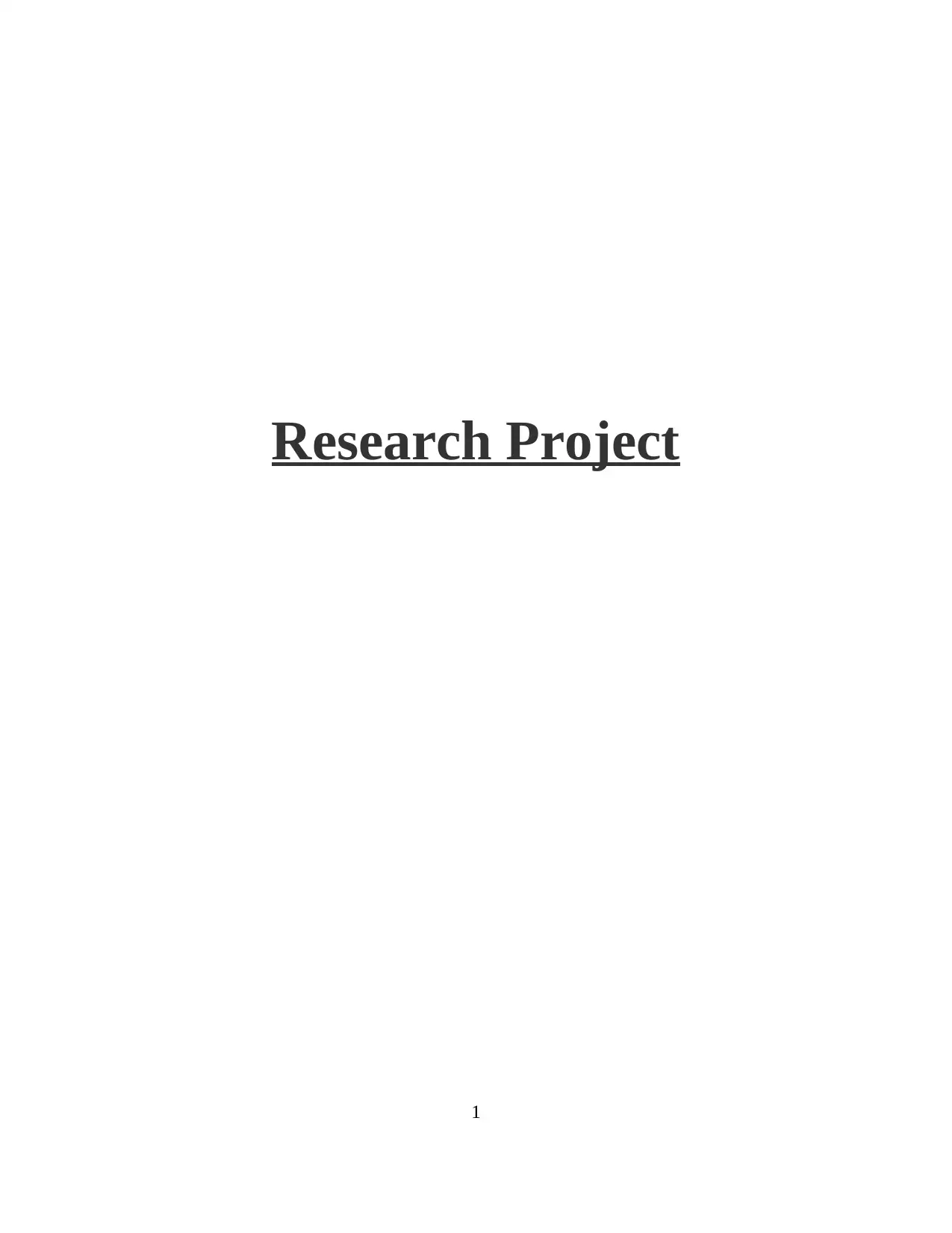
Research Project
1
1
Paraphrase This Document
Need a fresh take? Get an instant paraphrase of this document with our AI Paraphraser
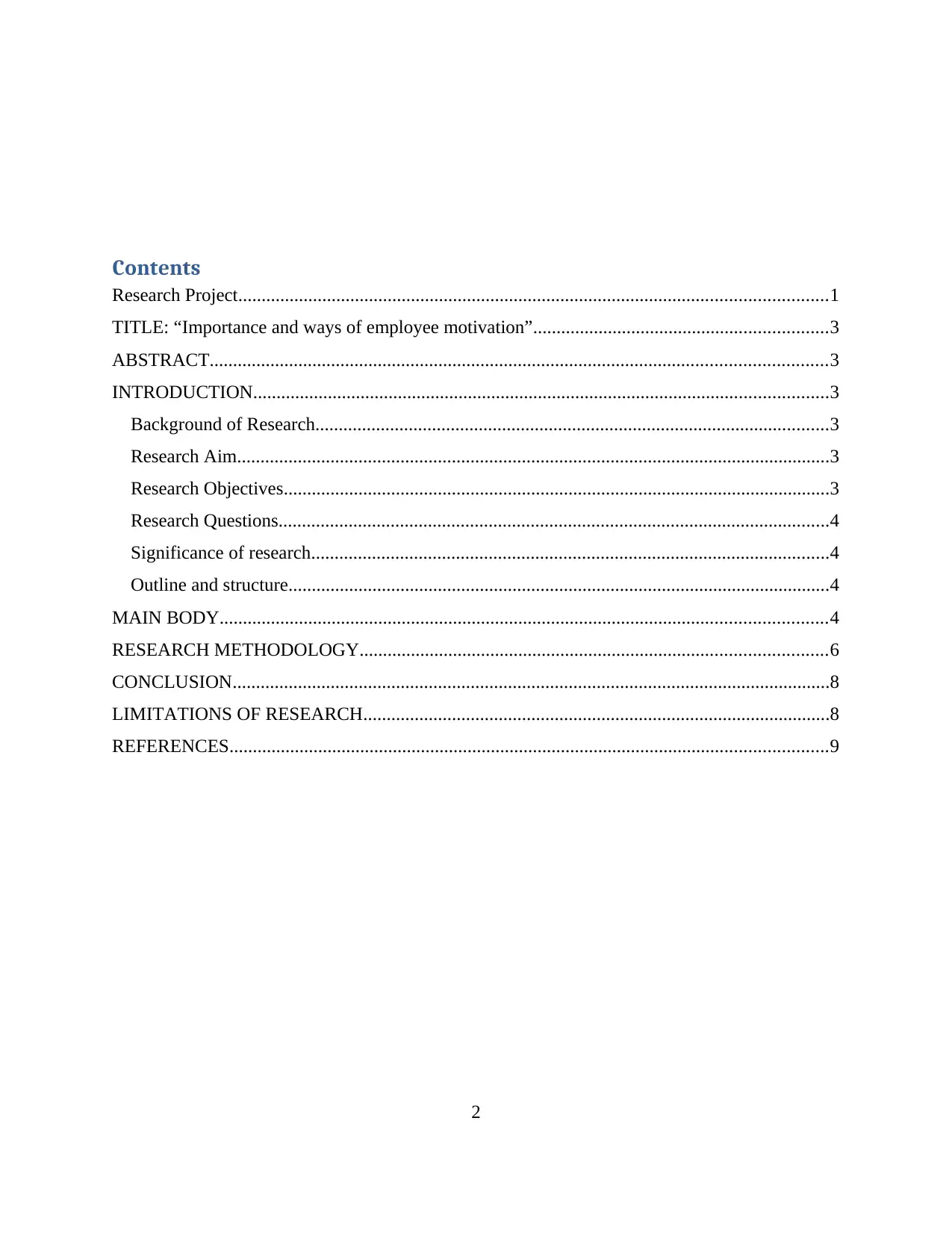
Contents
Research Project..............................................................................................................................1
TITLE: “Importance and ways of employee motivation”...............................................................3
ABSTRACT....................................................................................................................................3
INTRODUCTION...........................................................................................................................3
Background of Research..............................................................................................................3
Research Aim...............................................................................................................................3
Research Objectives.....................................................................................................................3
Research Questions......................................................................................................................4
Significance of research...............................................................................................................4
Outline and structure....................................................................................................................4
MAIN BODY..................................................................................................................................4
RESEARCH METHODOLOGY....................................................................................................6
CONCLUSION................................................................................................................................8
LIMITATIONS OF RESEARCH....................................................................................................8
REFERENCES................................................................................................................................9
2
Research Project..............................................................................................................................1
TITLE: “Importance and ways of employee motivation”...............................................................3
ABSTRACT....................................................................................................................................3
INTRODUCTION...........................................................................................................................3
Background of Research..............................................................................................................3
Research Aim...............................................................................................................................3
Research Objectives.....................................................................................................................3
Research Questions......................................................................................................................4
Significance of research...............................................................................................................4
Outline and structure....................................................................................................................4
MAIN BODY..................................................................................................................................4
RESEARCH METHODOLOGY....................................................................................................6
CONCLUSION................................................................................................................................8
LIMITATIONS OF RESEARCH....................................................................................................8
REFERENCES................................................................................................................................9
2

3
⊘ This is a preview!⊘
Do you want full access?
Subscribe today to unlock all pages.

Trusted by 1+ million students worldwide
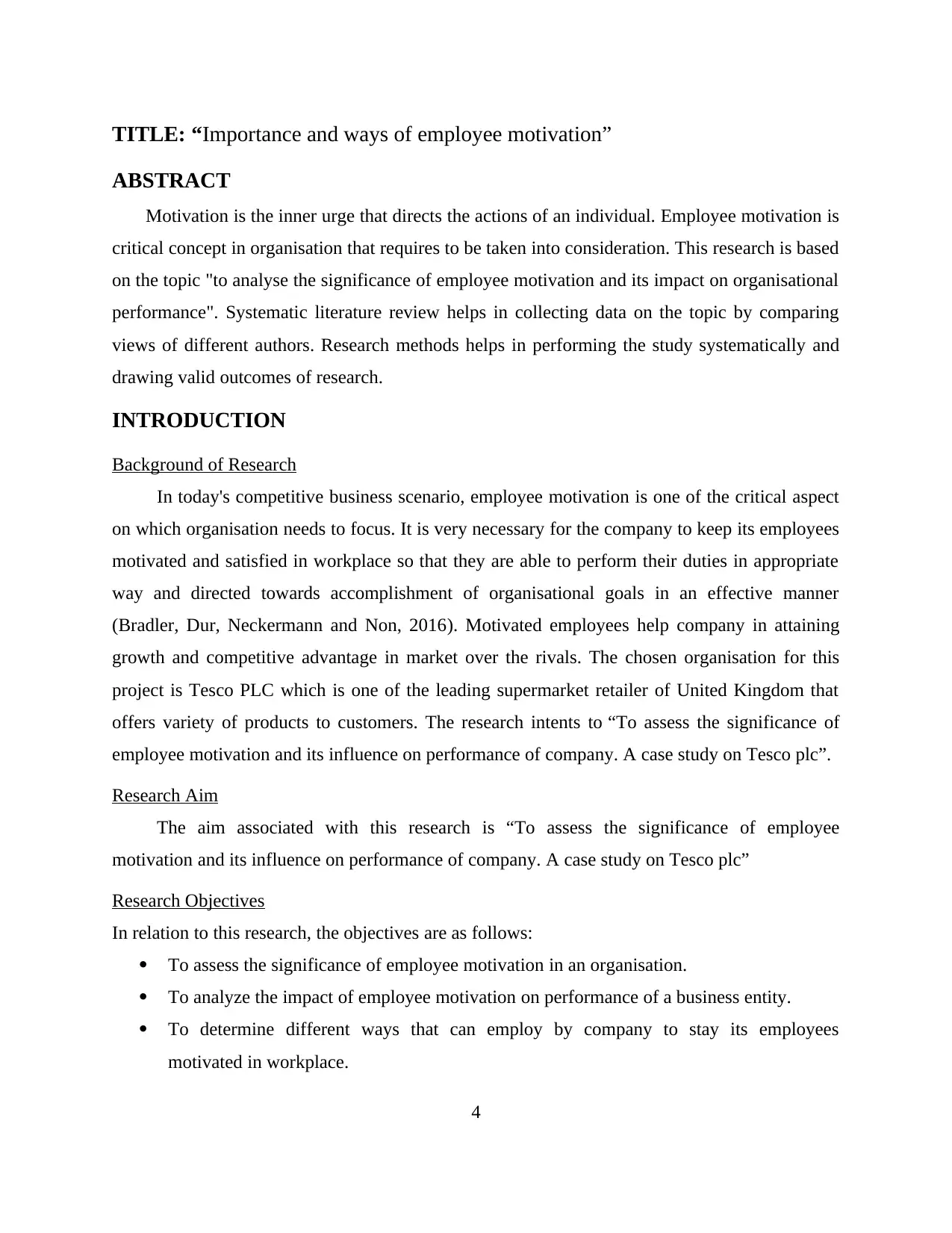
TITLE: “Importance and ways of employee motivation”
ABSTRACT
Motivation is the inner urge that directs the actions of an individual. Employee motivation is
critical concept in organisation that requires to be taken into consideration. This research is based
on the topic "to analyse the significance of employee motivation and its impact on organisational
performance". Systematic literature review helps in collecting data on the topic by comparing
views of different authors. Research methods helps in performing the study systematically and
drawing valid outcomes of research.
INTRODUCTION
Background of Research
In today's competitive business scenario, employee motivation is one of the critical aspect
on which organisation needs to focus. It is very necessary for the company to keep its employees
motivated and satisfied in workplace so that they are able to perform their duties in appropriate
way and directed towards accomplishment of organisational goals in an effective manner
(Bradler, Dur, Neckermann and Non, 2016). Motivated employees help company in attaining
growth and competitive advantage in market over the rivals. The chosen organisation for this
project is Tesco PLC which is one of the leading supermarket retailer of United Kingdom that
offers variety of products to customers. The research intents to “To assess the significance of
employee motivation and its influence on performance of company. A case study on Tesco plc”.
Research Aim
The aim associated with this research is “To assess the significance of employee
motivation and its influence on performance of company. A case study on Tesco plc”
Research Objectives
In relation to this research, the objectives are as follows:
To assess the significance of employee motivation in an organisation.
To analyze the impact of employee motivation on performance of a business entity.
To determine different ways that can employ by company to stay its employees
motivated in workplace.
4
ABSTRACT
Motivation is the inner urge that directs the actions of an individual. Employee motivation is
critical concept in organisation that requires to be taken into consideration. This research is based
on the topic "to analyse the significance of employee motivation and its impact on organisational
performance". Systematic literature review helps in collecting data on the topic by comparing
views of different authors. Research methods helps in performing the study systematically and
drawing valid outcomes of research.
INTRODUCTION
Background of Research
In today's competitive business scenario, employee motivation is one of the critical aspect
on which organisation needs to focus. It is very necessary for the company to keep its employees
motivated and satisfied in workplace so that they are able to perform their duties in appropriate
way and directed towards accomplishment of organisational goals in an effective manner
(Bradler, Dur, Neckermann and Non, 2016). Motivated employees help company in attaining
growth and competitive advantage in market over the rivals. The chosen organisation for this
project is Tesco PLC which is one of the leading supermarket retailer of United Kingdom that
offers variety of products to customers. The research intents to “To assess the significance of
employee motivation and its influence on performance of company. A case study on Tesco plc”.
Research Aim
The aim associated with this research is “To assess the significance of employee
motivation and its influence on performance of company. A case study on Tesco plc”
Research Objectives
In relation to this research, the objectives are as follows:
To assess the significance of employee motivation in an organisation.
To analyze the impact of employee motivation on performance of a business entity.
To determine different ways that can employ by company to stay its employees
motivated in workplace.
4
Paraphrase This Document
Need a fresh take? Get an instant paraphrase of this document with our AI Paraphraser
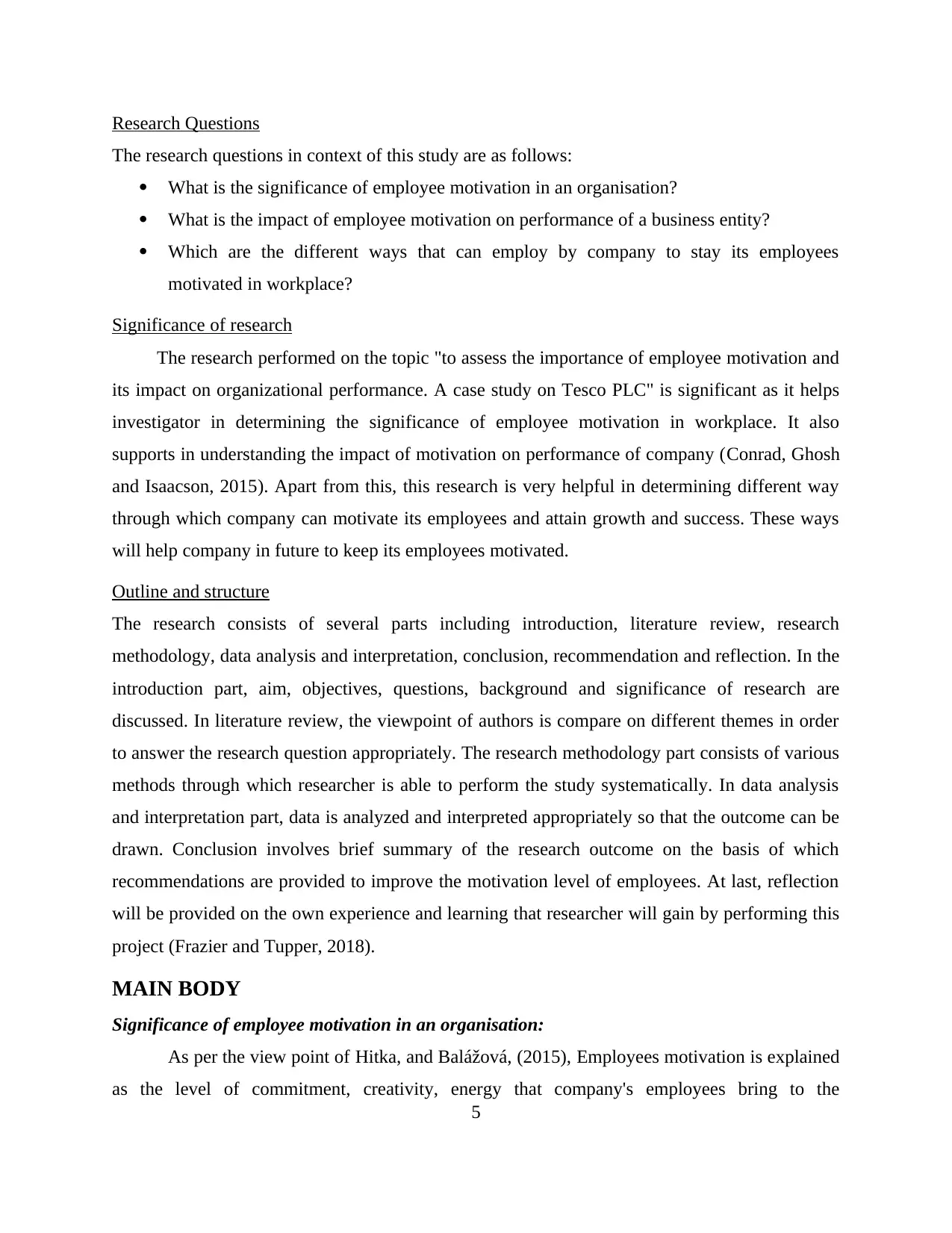
Research Questions
The research questions in context of this study are as follows:
What is the significance of employee motivation in an organisation?
What is the impact of employee motivation on performance of a business entity?
Which are the different ways that can employ by company to stay its employees
motivated in workplace?
Significance of research
The research performed on the topic "to assess the importance of employee motivation and
its impact on organizational performance. A case study on Tesco PLC" is significant as it helps
investigator in determining the significance of employee motivation in workplace. It also
supports in understanding the impact of motivation on performance of company (Conrad, Ghosh
and Isaacson, 2015). Apart from this, this research is very helpful in determining different way
through which company can motivate its employees and attain growth and success. These ways
will help company in future to keep its employees motivated.
Outline and structure
The research consists of several parts including introduction, literature review, research
methodology, data analysis and interpretation, conclusion, recommendation and reflection. In the
introduction part, aim, objectives, questions, background and significance of research are
discussed. In literature review, the viewpoint of authors is compare on different themes in order
to answer the research question appropriately. The research methodology part consists of various
methods through which researcher is able to perform the study systematically. In data analysis
and interpretation part, data is analyzed and interpreted appropriately so that the outcome can be
drawn. Conclusion involves brief summary of the research outcome on the basis of which
recommendations are provided to improve the motivation level of employees. At last, reflection
will be provided on the own experience and learning that researcher will gain by performing this
project (Frazier and Tupper, 2018).
MAIN BODY
Significance of employee motivation in an organisation:
As per the view point of Hitka, and Balážová, (2015), Employees motivation is explained
as the level of commitment, creativity, energy that company's employees bring to the
5
The research questions in context of this study are as follows:
What is the significance of employee motivation in an organisation?
What is the impact of employee motivation on performance of a business entity?
Which are the different ways that can employ by company to stay its employees
motivated in workplace?
Significance of research
The research performed on the topic "to assess the importance of employee motivation and
its impact on organizational performance. A case study on Tesco PLC" is significant as it helps
investigator in determining the significance of employee motivation in workplace. It also
supports in understanding the impact of motivation on performance of company (Conrad, Ghosh
and Isaacson, 2015). Apart from this, this research is very helpful in determining different way
through which company can motivate its employees and attain growth and success. These ways
will help company in future to keep its employees motivated.
Outline and structure
The research consists of several parts including introduction, literature review, research
methodology, data analysis and interpretation, conclusion, recommendation and reflection. In the
introduction part, aim, objectives, questions, background and significance of research are
discussed. In literature review, the viewpoint of authors is compare on different themes in order
to answer the research question appropriately. The research methodology part consists of various
methods through which researcher is able to perform the study systematically. In data analysis
and interpretation part, data is analyzed and interpreted appropriately so that the outcome can be
drawn. Conclusion involves brief summary of the research outcome on the basis of which
recommendations are provided to improve the motivation level of employees. At last, reflection
will be provided on the own experience and learning that researcher will gain by performing this
project (Frazier and Tupper, 2018).
MAIN BODY
Significance of employee motivation in an organisation:
As per the view point of Hitka, and Balážová, (2015), Employees motivation is explained
as the level of commitment, creativity, energy that company's employees bring to the
5
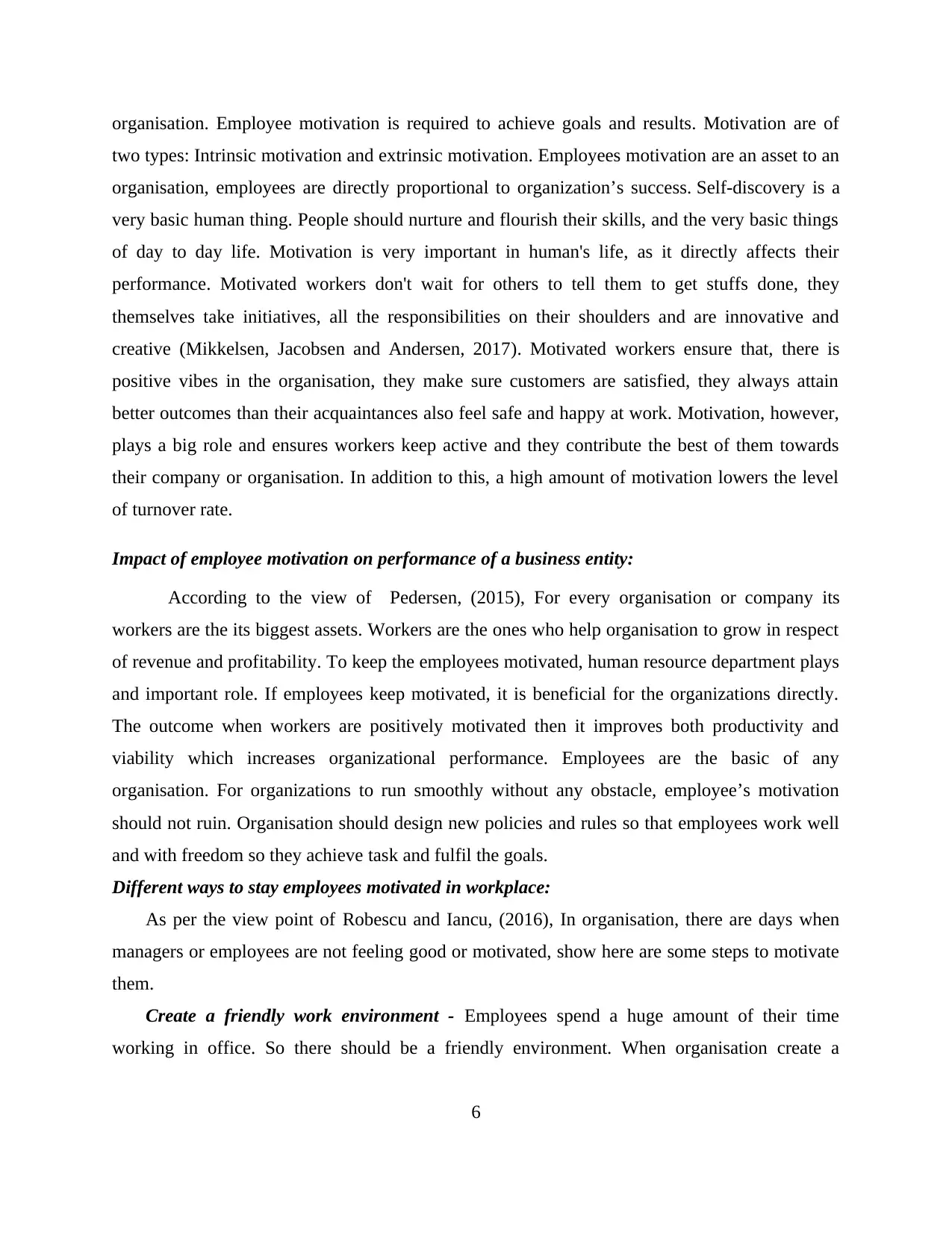
organisation. Employee motivation is required to achieve goals and results. Motivation are of
two types: Intrinsic motivation and extrinsic motivation. Employees motivation are an asset to an
organisation, employees are directly proportional to organization’s success. Self-discovery is a
very basic human thing. People should nurture and flourish their skills, and the very basic things
of day to day life. Motivation is very important in human's life, as it directly affects their
performance. Motivated workers don't wait for others to tell them to get stuffs done, they
themselves take initiatives, all the responsibilities on their shoulders and are innovative and
creative (Mikkelsen, Jacobsen and Andersen, 2017). Motivated workers ensure that, there is
positive vibes in the organisation, they make sure customers are satisfied, they always attain
better outcomes than their acquaintances also feel safe and happy at work. Motivation, however,
plays a big role and ensures workers keep active and they contribute the best of them towards
their company or organisation. In addition to this, a high amount of motivation lowers the level
of turnover rate.
Impact of employee motivation on performance of a business entity:
According to the view of Pedersen, (2015), For every organisation or company its
workers are the its biggest assets. Workers are the ones who help organisation to grow in respect
of revenue and profitability. To keep the employees motivated, human resource department plays
and important role. If employees keep motivated, it is beneficial for the organizations directly.
The outcome when workers are positively motivated then it improves both productivity and
viability which increases organizational performance. Employees are the basic of any
organisation. For organizations to run smoothly without any obstacle, employee’s motivation
should not ruin. Organisation should design new policies and rules so that employees work well
and with freedom so they achieve task and fulfil the goals.
Different ways to stay employees motivated in workplace:
As per the view point of Robescu and Iancu, (2016), In organisation, there are days when
managers or employees are not feeling good or motivated, show here are some steps to motivate
them.
Create a friendly work environment - Employees spend a huge amount of their time
working in office. So there should be a friendly environment. When organisation create a
6
two types: Intrinsic motivation and extrinsic motivation. Employees motivation are an asset to an
organisation, employees are directly proportional to organization’s success. Self-discovery is a
very basic human thing. People should nurture and flourish their skills, and the very basic things
of day to day life. Motivation is very important in human's life, as it directly affects their
performance. Motivated workers don't wait for others to tell them to get stuffs done, they
themselves take initiatives, all the responsibilities on their shoulders and are innovative and
creative (Mikkelsen, Jacobsen and Andersen, 2017). Motivated workers ensure that, there is
positive vibes in the organisation, they make sure customers are satisfied, they always attain
better outcomes than their acquaintances also feel safe and happy at work. Motivation, however,
plays a big role and ensures workers keep active and they contribute the best of them towards
their company or organisation. In addition to this, a high amount of motivation lowers the level
of turnover rate.
Impact of employee motivation on performance of a business entity:
According to the view of Pedersen, (2015), For every organisation or company its
workers are the its biggest assets. Workers are the ones who help organisation to grow in respect
of revenue and profitability. To keep the employees motivated, human resource department plays
and important role. If employees keep motivated, it is beneficial for the organizations directly.
The outcome when workers are positively motivated then it improves both productivity and
viability which increases organizational performance. Employees are the basic of any
organisation. For organizations to run smoothly without any obstacle, employee’s motivation
should not ruin. Organisation should design new policies and rules so that employees work well
and with freedom so they achieve task and fulfil the goals.
Different ways to stay employees motivated in workplace:
As per the view point of Robescu and Iancu, (2016), In organisation, there are days when
managers or employees are not feeling good or motivated, show here are some steps to motivate
them.
Create a friendly work environment - Employees spend a huge amount of their time
working in office. So there should be a friendly environment. When organisation create a
6
⊘ This is a preview!⊘
Do you want full access?
Subscribe today to unlock all pages.

Trusted by 1+ million students worldwide
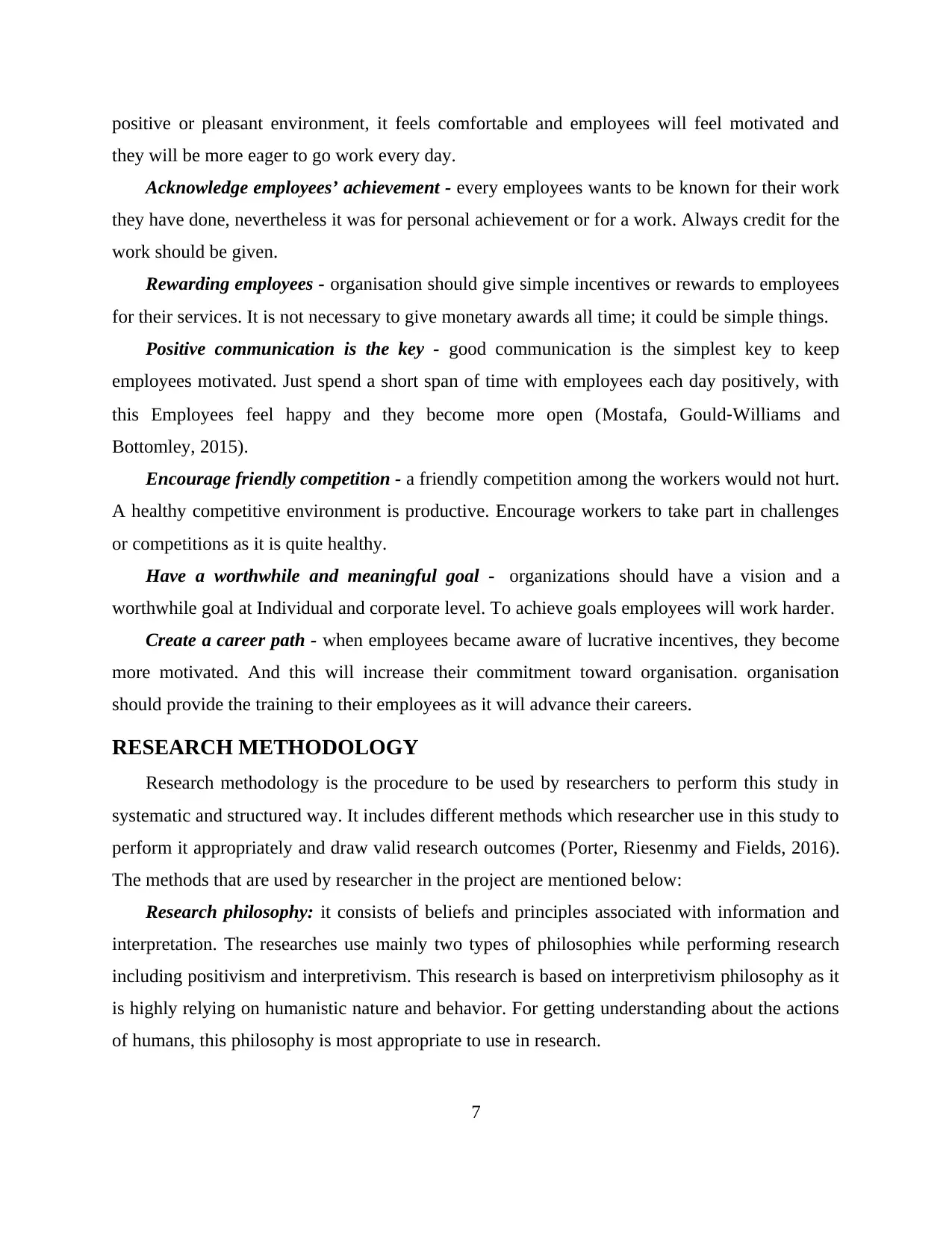
positive or pleasant environment, it feels comfortable and employees will feel motivated and
they will be more eager to go work every day.
Acknowledge employees’ achievement - every employees wants to be known for their work
they have done, nevertheless it was for personal achievement or for a work. Always credit for the
work should be given.
Rewarding employees - organisation should give simple incentives or rewards to employees
for their services. It is not necessary to give monetary awards all time; it could be simple things.
Positive communication is the key - good communication is the simplest key to keep
employees motivated. Just spend a short span of time with employees each day positively, with
this Employees feel happy and they become more open (Mostafa, Gould‐Williams and
Bottomley, 2015).
Encourage friendly competition - a friendly competition among the workers would not hurt.
A healthy competitive environment is productive. Encourage workers to take part in challenges
or competitions as it is quite healthy.
Have a worthwhile and meaningful goal - organizations should have a vision and a
worthwhile goal at Individual and corporate level. To achieve goals employees will work harder.
Create a career path - when employees became aware of lucrative incentives, they become
more motivated. And this will increase their commitment toward organisation. organisation
should provide the training to their employees as it will advance their careers.
RESEARCH METHODOLOGY
Research methodology is the procedure to be used by researchers to perform this study in
systematic and structured way. It includes different methods which researcher use in this study to
perform it appropriately and draw valid research outcomes (Porter, Riesenmy and Fields, 2016).
The methods that are used by researcher in the project are mentioned below:
Research philosophy: it consists of beliefs and principles associated with information and
interpretation. The researches use mainly two types of philosophies while performing research
including positivism and interpretivism. This research is based on interpretivism philosophy as it
is highly relying on humanistic nature and behavior. For getting understanding about the actions
of humans, this philosophy is most appropriate to use in research.
7
they will be more eager to go work every day.
Acknowledge employees’ achievement - every employees wants to be known for their work
they have done, nevertheless it was for personal achievement or for a work. Always credit for the
work should be given.
Rewarding employees - organisation should give simple incentives or rewards to employees
for their services. It is not necessary to give monetary awards all time; it could be simple things.
Positive communication is the key - good communication is the simplest key to keep
employees motivated. Just spend a short span of time with employees each day positively, with
this Employees feel happy and they become more open (Mostafa, Gould‐Williams and
Bottomley, 2015).
Encourage friendly competition - a friendly competition among the workers would not hurt.
A healthy competitive environment is productive. Encourage workers to take part in challenges
or competitions as it is quite healthy.
Have a worthwhile and meaningful goal - organizations should have a vision and a
worthwhile goal at Individual and corporate level. To achieve goals employees will work harder.
Create a career path - when employees became aware of lucrative incentives, they become
more motivated. And this will increase their commitment toward organisation. organisation
should provide the training to their employees as it will advance their careers.
RESEARCH METHODOLOGY
Research methodology is the procedure to be used by researchers to perform this study in
systematic and structured way. It includes different methods which researcher use in this study to
perform it appropriately and draw valid research outcomes (Porter, Riesenmy and Fields, 2016).
The methods that are used by researcher in the project are mentioned below:
Research philosophy: it consists of beliefs and principles associated with information and
interpretation. The researches use mainly two types of philosophies while performing research
including positivism and interpretivism. This research is based on interpretivism philosophy as it
is highly relying on humanistic nature and behavior. For getting understanding about the actions
of humans, this philosophy is most appropriate to use in research.
7
Paraphrase This Document
Need a fresh take? Get an instant paraphrase of this document with our AI Paraphraser
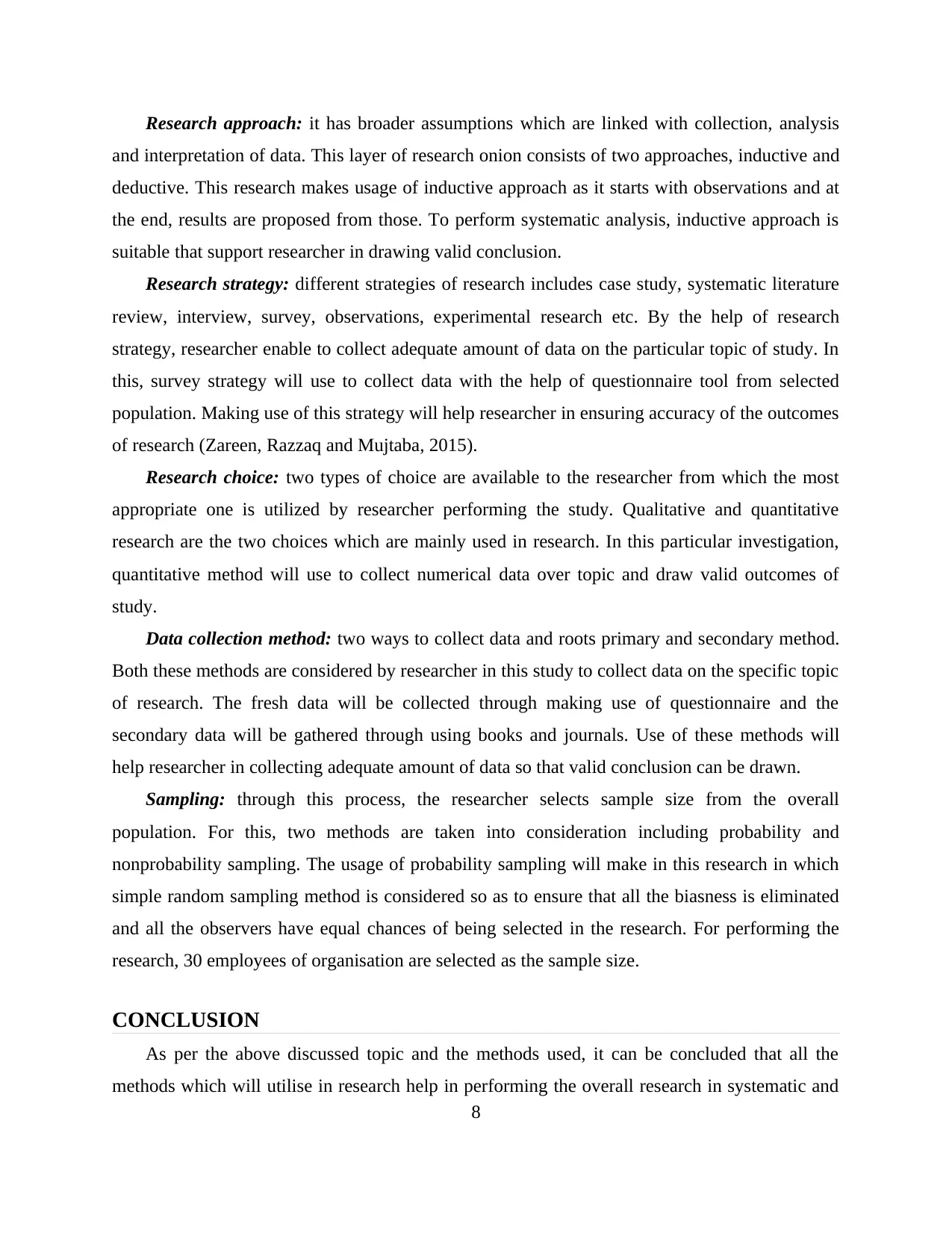
Research approach: it has broader assumptions which are linked with collection, analysis
and interpretation of data. This layer of research onion consists of two approaches, inductive and
deductive. This research makes usage of inductive approach as it starts with observations and at
the end, results are proposed from those. To perform systematic analysis, inductive approach is
suitable that support researcher in drawing valid conclusion.
Research strategy: different strategies of research includes case study, systematic literature
review, interview, survey, observations, experimental research etc. By the help of research
strategy, researcher enable to collect adequate amount of data on the particular topic of study. In
this, survey strategy will use to collect data with the help of questionnaire tool from selected
population. Making use of this strategy will help researcher in ensuring accuracy of the outcomes
of research (Zareen, Razzaq and Mujtaba, 2015).
Research choice: two types of choice are available to the researcher from which the most
appropriate one is utilized by researcher performing the study. Qualitative and quantitative
research are the two choices which are mainly used in research. In this particular investigation,
quantitative method will use to collect numerical data over topic and draw valid outcomes of
study.
Data collection method: two ways to collect data and roots primary and secondary method.
Both these methods are considered by researcher in this study to collect data on the specific topic
of research. The fresh data will be collected through making use of questionnaire and the
secondary data will be gathered through using books and journals. Use of these methods will
help researcher in collecting adequate amount of data so that valid conclusion can be drawn.
Sampling: through this process, the researcher selects sample size from the overall
population. For this, two methods are taken into consideration including probability and
nonprobability sampling. The usage of probability sampling will make in this research in which
simple random sampling method is considered so as to ensure that all the biasness is eliminated
and all the observers have equal chances of being selected in the research. For performing the
research, 30 employees of organisation are selected as the sample size.
CONCLUSION
As per the above discussed topic and the methods used, it can be concluded that all the
methods which will utilise in research help in performing the overall research in systematic and
8
and interpretation of data. This layer of research onion consists of two approaches, inductive and
deductive. This research makes usage of inductive approach as it starts with observations and at
the end, results are proposed from those. To perform systematic analysis, inductive approach is
suitable that support researcher in drawing valid conclusion.
Research strategy: different strategies of research includes case study, systematic literature
review, interview, survey, observations, experimental research etc. By the help of research
strategy, researcher enable to collect adequate amount of data on the particular topic of study. In
this, survey strategy will use to collect data with the help of questionnaire tool from selected
population. Making use of this strategy will help researcher in ensuring accuracy of the outcomes
of research (Zareen, Razzaq and Mujtaba, 2015).
Research choice: two types of choice are available to the researcher from which the most
appropriate one is utilized by researcher performing the study. Qualitative and quantitative
research are the two choices which are mainly used in research. In this particular investigation,
quantitative method will use to collect numerical data over topic and draw valid outcomes of
study.
Data collection method: two ways to collect data and roots primary and secondary method.
Both these methods are considered by researcher in this study to collect data on the specific topic
of research. The fresh data will be collected through making use of questionnaire and the
secondary data will be gathered through using books and journals. Use of these methods will
help researcher in collecting adequate amount of data so that valid conclusion can be drawn.
Sampling: through this process, the researcher selects sample size from the overall
population. For this, two methods are taken into consideration including probability and
nonprobability sampling. The usage of probability sampling will make in this research in which
simple random sampling method is considered so as to ensure that all the biasness is eliminated
and all the observers have equal chances of being selected in the research. For performing the
research, 30 employees of organisation are selected as the sample size.
CONCLUSION
As per the above discussed topic and the methods used, it can be concluded that all the
methods which will utilise in research help in performing the overall research in systematic and
8
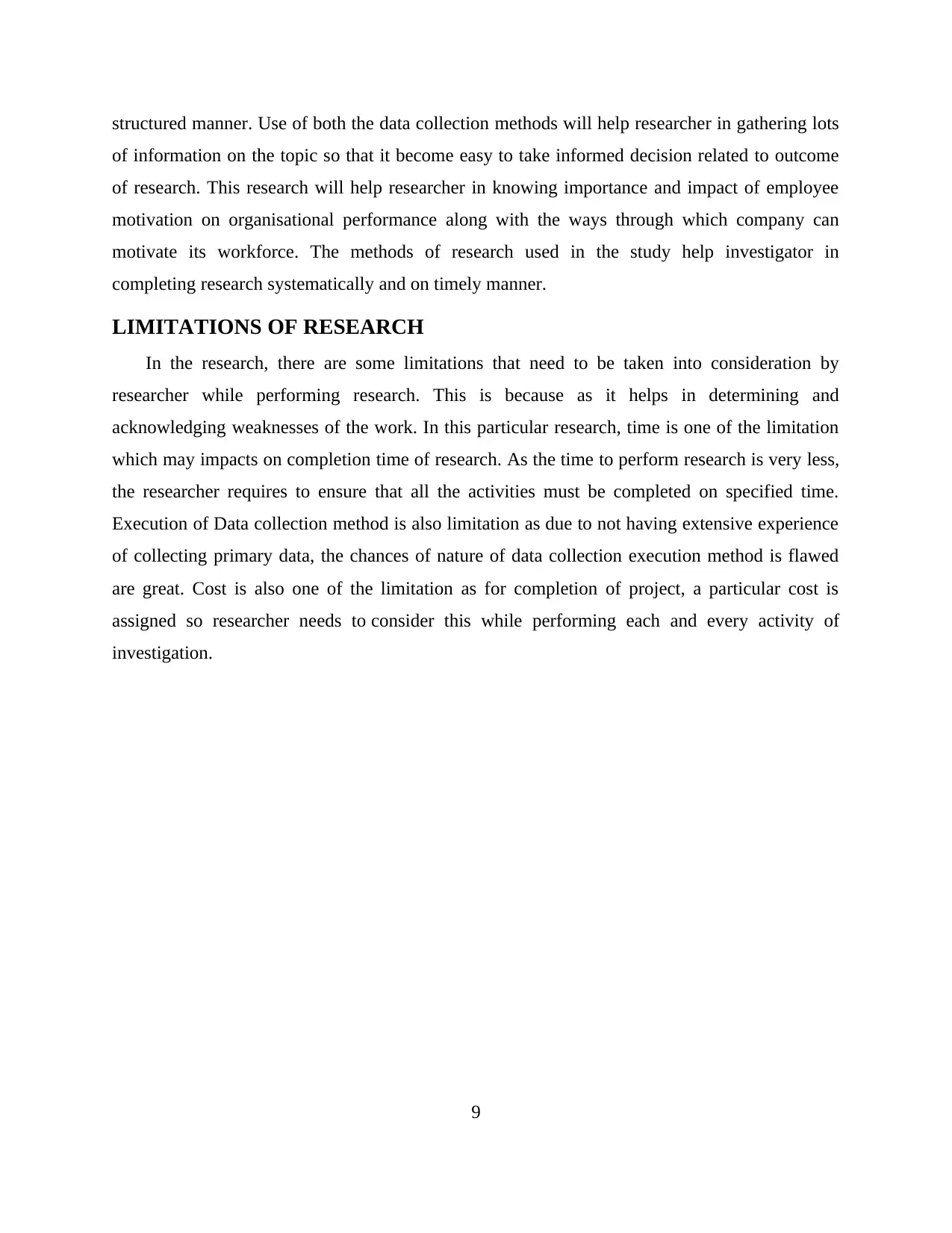
structured manner. Use of both the data collection methods will help researcher in gathering lots
of information on the topic so that it become easy to take informed decision related to outcome
of research. This research will help researcher in knowing importance and impact of employee
motivation on organisational performance along with the ways through which company can
motivate its workforce. The methods of research used in the study help investigator in
completing research systematically and on timely manner.
LIMITATIONS OF RESEARCH
In the research, there are some limitations that need to be taken into consideration by
researcher while performing research. This is because as it helps in determining and
acknowledging weaknesses of the work. In this particular research, time is one of the limitation
which may impacts on completion time of research. As the time to perform research is very less,
the researcher requires to ensure that all the activities must be completed on specified time.
Execution of Data collection method is also limitation as due to not having extensive experience
of collecting primary data, the chances of nature of data collection execution method is flawed
are great. Cost is also one of the limitation as for completion of project, a particular cost is
assigned so researcher needs to consider this while performing each and every activity of
investigation.
9
of information on the topic so that it become easy to take informed decision related to outcome
of research. This research will help researcher in knowing importance and impact of employee
motivation on organisational performance along with the ways through which company can
motivate its workforce. The methods of research used in the study help investigator in
completing research systematically and on timely manner.
LIMITATIONS OF RESEARCH
In the research, there are some limitations that need to be taken into consideration by
researcher while performing research. This is because as it helps in determining and
acknowledging weaknesses of the work. In this particular research, time is one of the limitation
which may impacts on completion time of research. As the time to perform research is very less,
the researcher requires to ensure that all the activities must be completed on specified time.
Execution of Data collection method is also limitation as due to not having extensive experience
of collecting primary data, the chances of nature of data collection execution method is flawed
are great. Cost is also one of the limitation as for completion of project, a particular cost is
assigned so researcher needs to consider this while performing each and every activity of
investigation.
9
⊘ This is a preview!⊘
Do you want full access?
Subscribe today to unlock all pages.

Trusted by 1+ million students worldwide
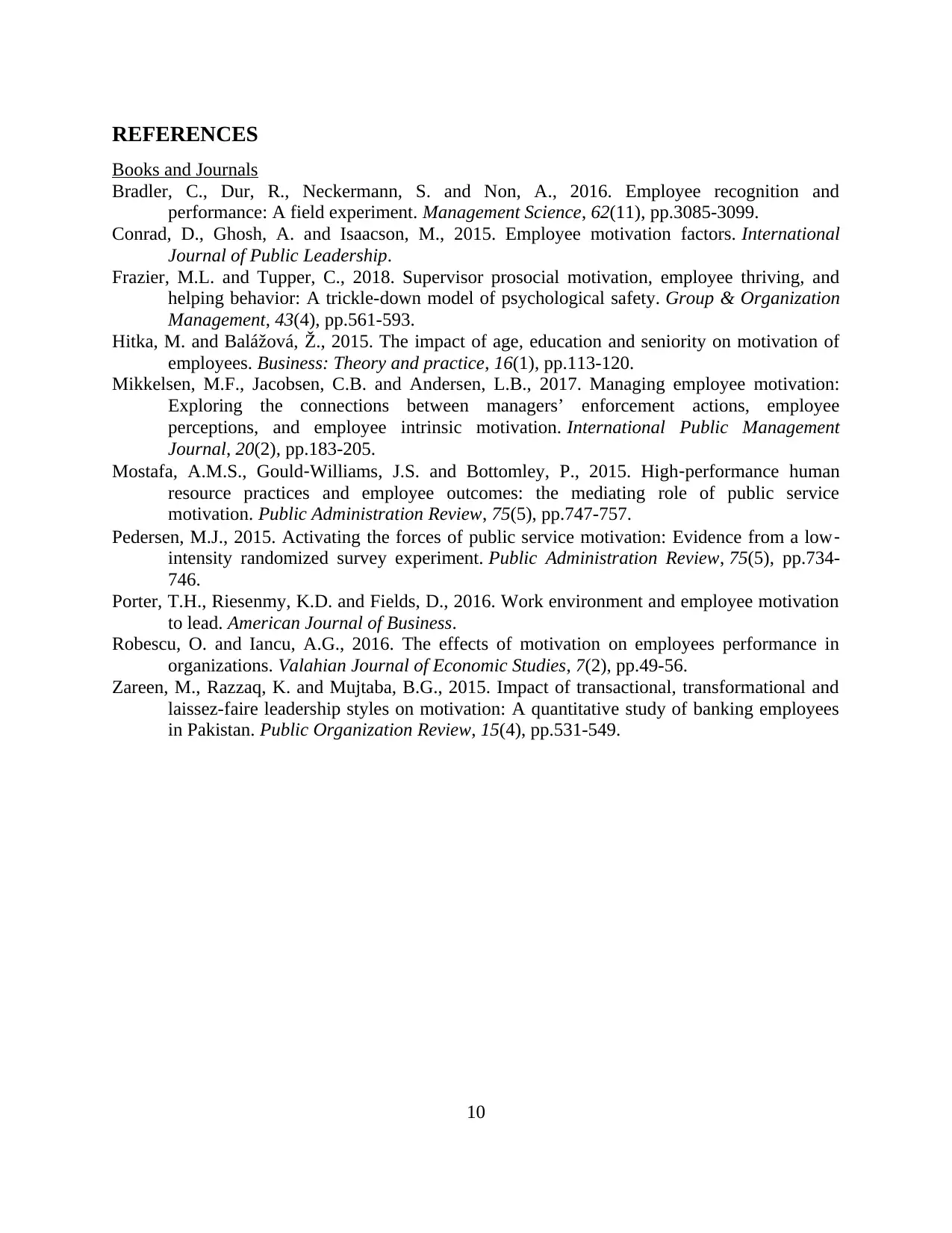
REFERENCES
Books and Journals
Bradler, C., Dur, R., Neckermann, S. and Non, A., 2016. Employee recognition and
performance: A field experiment. Management Science, 62(11), pp.3085-3099.
Conrad, D., Ghosh, A. and Isaacson, M., 2015. Employee motivation factors. International
Journal of Public Leadership.
Frazier, M.L. and Tupper, C., 2018. Supervisor prosocial motivation, employee thriving, and
helping behavior: A trickle-down model of psychological safety. Group & Organization
Management, 43(4), pp.561-593.
Hitka, M. and Balážová, Ž., 2015. The impact of age, education and seniority on motivation of
employees. Business: Theory and practice, 16(1), pp.113-120.
Mikkelsen, M.F., Jacobsen, C.B. and Andersen, L.B., 2017. Managing employee motivation:
Exploring the connections between managers’ enforcement actions, employee
perceptions, and employee intrinsic motivation. International Public Management
Journal, 20(2), pp.183-205.
Mostafa, A.M.S., Gould‐Williams, J.S. and Bottomley, P., 2015. High‐performance human
resource practices and employee outcomes: the mediating role of public service
motivation. Public Administration Review, 75(5), pp.747-757.
Pedersen, M.J., 2015. Activating the forces of public service motivation: Evidence from a low‐
intensity randomized survey experiment. Public Administration Review, 75(5), pp.734-
746.
Porter, T.H., Riesenmy, K.D. and Fields, D., 2016. Work environment and employee motivation
to lead. American Journal of Business.
Robescu, O. and Iancu, A.G., 2016. The effects of motivation on employees performance in
organizations. Valahian Journal of Economic Studies, 7(2), pp.49-56.
Zareen, M., Razzaq, K. and Mujtaba, B.G., 2015. Impact of transactional, transformational and
laissez-faire leadership styles on motivation: A quantitative study of banking employees
in Pakistan. Public Organization Review, 15(4), pp.531-549.
10
Books and Journals
Bradler, C., Dur, R., Neckermann, S. and Non, A., 2016. Employee recognition and
performance: A field experiment. Management Science, 62(11), pp.3085-3099.
Conrad, D., Ghosh, A. and Isaacson, M., 2015. Employee motivation factors. International
Journal of Public Leadership.
Frazier, M.L. and Tupper, C., 2018. Supervisor prosocial motivation, employee thriving, and
helping behavior: A trickle-down model of psychological safety. Group & Organization
Management, 43(4), pp.561-593.
Hitka, M. and Balážová, Ž., 2015. The impact of age, education and seniority on motivation of
employees. Business: Theory and practice, 16(1), pp.113-120.
Mikkelsen, M.F., Jacobsen, C.B. and Andersen, L.B., 2017. Managing employee motivation:
Exploring the connections between managers’ enforcement actions, employee
perceptions, and employee intrinsic motivation. International Public Management
Journal, 20(2), pp.183-205.
Mostafa, A.M.S., Gould‐Williams, J.S. and Bottomley, P., 2015. High‐performance human
resource practices and employee outcomes: the mediating role of public service
motivation. Public Administration Review, 75(5), pp.747-757.
Pedersen, M.J., 2015. Activating the forces of public service motivation: Evidence from a low‐
intensity randomized survey experiment. Public Administration Review, 75(5), pp.734-
746.
Porter, T.H., Riesenmy, K.D. and Fields, D., 2016. Work environment and employee motivation
to lead. American Journal of Business.
Robescu, O. and Iancu, A.G., 2016. The effects of motivation on employees performance in
organizations. Valahian Journal of Economic Studies, 7(2), pp.49-56.
Zareen, M., Razzaq, K. and Mujtaba, B.G., 2015. Impact of transactional, transformational and
laissez-faire leadership styles on motivation: A quantitative study of banking employees
in Pakistan. Public Organization Review, 15(4), pp.531-549.
10
1 out of 10
Related Documents
Your All-in-One AI-Powered Toolkit for Academic Success.
+13062052269
info@desklib.com
Available 24*7 on WhatsApp / Email
![[object Object]](/_next/static/media/star-bottom.7253800d.svg)
Unlock your academic potential
Copyright © 2020–2025 A2Z Services. All Rights Reserved. Developed and managed by ZUCOL.





